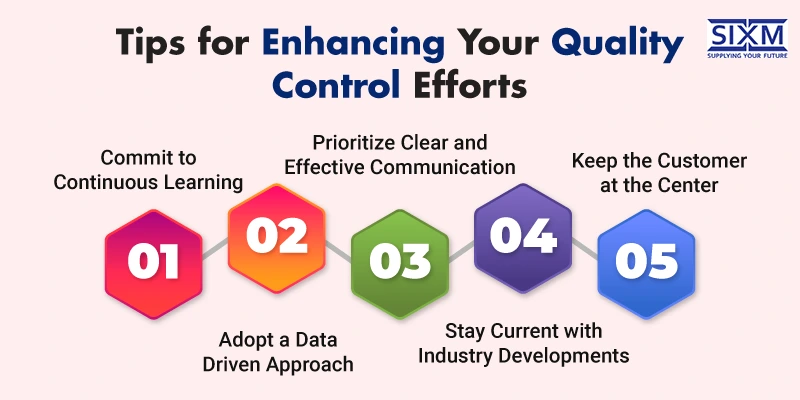
Quality control methods are structured techniques used to ensure that products and processes meet defined standards and specifications. They help businesses detect defects, prevent errors, and continuously improve performance. In industries like manufacturing, software development, logistics, and service delivery, the implementation of effective quality control methods plays a crucial role in reducing costs, improving customer satisfaction, and strengthening a brand’s reputation.
In this blog, we’ll explore the most effective quality control methods, how they work, and when to use them.
What Is Quality Control and Why Does It Matters?
Quality control is the process of ensuring that products meet specified quality standards and customer expectations. It involves testing, inspecting, and reviewing products or services at various stages of the production process to detect and correct defects or inconsistencies before they reach the customer.
Implementing effective quality control is essential for several reasons:
- Prevents defects and errors
- Enhances customer trust
- Improves operational efficiency
- Reduces rework and recalls
- Ensures compliance with industry regulations
Common Quality Control Methods
Over the years, various quality control methods have been developed and refined to help manufacturers reduce waste, increase efficiency, and meet stringent industry standards. Below, we explore some of the most widely used QC methods and how they contribute to consistent, high-quality production.

1. Statistical Process Control (SPC)
What it is:
Statistical Process Control (SPC) involves using statistical methods to monitor and control manufacturing processes. It relies on real-time data collection and analysis to identify and address variations before they result in defects.
How it works:
Data is gathered from key points in the production process and plotted on control charts. These charts highlight variations and trends that may signal process instability.
Where it's used:
- Automotive manufacturing
- Electronics assembly
- Precision engineering industries
Benefits:
- Early detection of abnormalities
- Maintains tight control over production variables
- Enhances product consistency
- Reduces scrap, rework, and downtime
2. Six Sigma
What it is:
Six Sigma is a rigorous, data-driven approach to quality management that aims to eliminate defects and reduce variability. It follows the DMAIC framework: Define, Measure, Analyze, Improve, and Control.
How it works:
Projects are carried out by certified Six Sigma professionals (Green Belts, Black Belts) who collect data and apply statistical tools to identify root causes and optimize processes.
Where it's used:
- Manufacturing (automotive, electronics, aerospace)
- Healthcare services
- Logistics and supply chain operations
Benefits:
- Quantitative process improvement
- Aligns business processes with customer needs
- Reduces costs associated with errors and inefficiencies
- Drives long-term organizational performance
3. Total Quality Management (TQM)
What it is:
TQM is a company-wide approach to embedding quality in all areas of an organization. It emphasizes continuous improvement, customer satisfaction, and employee involvement.
How it works:
TQM initiatives include training, quality circles, benchmarking, and systematic process reviews. It promotes a culture where every employee is responsible for quality.
Where it's used:
- Manufacturing sectors
- Service industries
- Government and education sectors
Benefits:
- Holistic quality ownership
- Boosts employee morale and engagement
- Improves operational efficiency
- Fosters innovation and adaptability
4. Lean Manufacturing
What it is:
Lean is a production philosophy aimed at reducing waste and maximizing value. In QC, it encourages standardization, visual controls, and mistake-proofing (poka-yoke).
How it works:
Lean uses tools such as value stream mapping, 5S, kanban, and just-in-time (JIT) production to streamline processes.
Where it's used:
- Automotive (e.g., Toyota Production System)
- Electronics and consumer goods
- Industrial manufacturing
Benefits:
- Increased efficiency and throughput
- Shorter production cycles
- Enhanced product quality
- Greater customer value
5. 100% Inspection
What it is:
Every unit of output is inspected to ensure it meets predetermined quality criteria. This method is typically applied where failures could have serious consequences.
How it works:
Inspections are carried out manually or with automated tools to check all characteristics against specifications.
Where it's used:
- Aerospace component manufacturing
- Medical device production
- High-precision or safety-critical applications
Benefits:
- Eliminates the risk of defective units reaching end-users
- Provides maximum assurance in critical industries
- Supports compliance with stringent regulatory standards
Limitations:
- Time-consuming and costly
- May not be feasible for large-volume production
6. Acceptance Sampling
What it is:
Acceptance Sampling involves evaluating a subset of items from a production lot to determine whether the entire batch meets quality requirements.
How it works:
Statistical sampling plans (e.g., ANSI/ASQ Z1.4) define how many items to sample and the allowable defect levels.
Where it's used:
- Large batch production
- Incoming goods inspection
- Supplier quality audits
Benefits:
- Cost-effective alternative to full inspection
- Helps maintain consistent quality with manageable resources
- Reduces inspection time
Limitations:
- Risk of accepting defective lots
- Does not identify specific causes of defects
7. Root Cause Analysis (RCA)
What it is:
RCA is a structured approach for identifying the root causes of quality issues, enabling organizations to develop long-term corrective and preventive actions (CAPA).
How it works: Common tools include:
- 5 Whys: Asking "why" repeatedly to reach the core issue.
- Fishbone Diagram (Ishikawa): Visualizes potential causes across categories (e.g., people, processes, machines).
- Fault Tree Analysis: Breaks down possible failure modes hierarchically.
Where it's used:
- Manufacturing defect investigations
- Product recalls and CAPA reports
- Safety and reliability engineering
Benefits:
- Prevents recurrence of defects
- Improves systemic thinking in quality teams
- Enhances reliability and compliance
How to Select the Most Effective Quality Control Method
The most effective QC strategy depends on multiple interrelated factors:
- Industry Requirements Certain industries like aerospace, pharmaceuticals, or food processing have stringent standards that may necessitate ISO compliance, Six Sigma, or TQM frameworks.
- Production Volume and Complexity High-volume operations often benefit from automated quality control or acceptance sampling. For complex or precision-based products, methods like Statistical Process Control (SPC) or Six Sigma are more suitable.
- Risk Level of Defects In industries where defects can pose safety or financial risks, preventive methods like Process Control and Root Cause Analysis are essential to proactively identify and eliminate sources of error.
- Regulatory Environment Regulatory demands may require rigorous documentation, auditing, and traceability—making ISO 9001 or other compliance-based methods necessary.
- Available Resources and Expertise The right QC approach must align with your technical capabilities, workforce skills, and budget. For example, smaller operations may start with basic inspection-based QC and scale to more advanced systems over time.
Matching QC Methods to Your Needs
To simplify the selection process, here is a reference chart linking common business priorities to ideal QC methods:
| Factor | Ideal QC Method(s) |
|---|---|
| Product volume | Acceptance Sampling, Automated Quality Control |
| Product complexity | Process Control, Six Sigma |
| Budget constraints | Inspection-Based Quality Control |
| Customer/Industry requirements | ISO Compliance, Total Quality Management (TQM) |
| Speed and scalability needs | Automated Quality Control |
| High risk of defects | Root Cause Analysis, Statistical Process Control |
In practice, most companies adopt a hybrid quality control strategy. For example:
- Statistical Process Control (SPC) may be used to monitor ongoing production.
- Acceptance Sampling can provide efficient checks for incoming or outgoing goods
- Root Cause Analysis (RCA) ensures that any discovered defect is thoroughly investigated and addressed.
This layered approach helps businesses maintain both proactive and reactive quality measures, enhancing reliability and customer satisfaction.
Tips for Enhancing Your Quality Control Efforts
Whether you're a seasoned quality control professional or just beginning your journey in the field, continuous improvement is key to maintaining high standards and delivering exceptional results. Here are essential strategies to strengthen your quality control management:

1. Commit to Continuous Learning
Invest in your professional growth by pursuing industry-recognized certifications and training programs. Expanding your expertise not only sharpens your skills but also opens doors to new career opportunities and best practices.
2. Adopt a Data Driven Approach
Leverage advanced analytics and digital tools to gain deep insights into quality metrics, defect patterns, and process efficiencies. A data-centric strategy enables more informed decision-making and supports proactive quality improvement.
3. Prioritize Clear and Effective Communication
Strong communication across teams, partners, and stakeholders is vital to ensuring alignment and accountability. Foster an environment of open dialogue where everyone understands their role in delivering high-quality outcomes.
4. Stay Current with Industry Developments
Keep pace with evolving standards, regulations, and emerging technologies by actively participating in workshops, webinars, and professional conferences. Staying informed allows you to adopt innovative techniques and remain competitive in your field.
5. Keep the Customer at the Center
Ultimately, quality control is about meeting and exceeding customer expectations. Regularly collect and analyze customer feedback to uncover opportunities for improvement and guide product or service enhancements that drive satisfaction and loyalty.
Exploring the role of supplier quality engineers in product reliability provides valuable insights for strengthening your quality control efforts.
Quality Control: A Continuous Journey with SIXM
Remember, quality control is not a one-time task but an ongoing commitment that drives business excellence and sustainable growth. Start integrating these methods today to pave the way for a stronger, more competitive future.
At SIXM, quality control is a fundamental part of our procurement and sourcing services. We specialize in helping businesses source high-quality materials and products while implementing tailored quality control methods that ensure consistent performance and reliability.
By combining industry best practices with rigorous supplier evaluation and monitoring, SIXM helps organizations minimize defects, optimize supply chain processes, and exceed customer expectations.
We believe quality is not just a standard but a strategic advantage. Partner with SIXM to strengthen your procurement and sourcing efforts and achieve lasting success in your industry.

